

Compact Muon Solenoid
LHC, CERN
| CMS-PAS-SMP-24-009 | ||
| Measurement of the W→cq/W→qˉq′ decay branching fraction ratio in proton-proton collisions at √s= 13 TeV | ||
| CMS Collaboration | ||
| 18 July 2024 | ||
| Abstract: The most precise measurement to date of the W boson hadronic decay branching fraction ratio RWc=B(W→cq)/B(W→qˉq′) is presented. The measurement is based on a sample of proton-proton collision data from the CERN LHC collected by the CMS experiment at a center-of-mass energy of 13 TeV in 2016-2018 and corresponding to an integrated luminosity of 138 fb−1. The large cross section of top quark-antiquark production at the LHC offers a sizable high-purity sample of W bosons suitable for this measurement. Events with one charged lepton (electron or muon) and at least four jets, two of them tagged as bottom quark jets, are analyzed. Charm jets are tagged using the presence of a muon inside the jet. The result, RWc = 0.489 ± 0.020, is consistent with the standard model prediction and improves the precision of the current world average value by a factor of two. From this measurement, the sum of squared elements in the second row of the CKM matrix, 0.970 ± 0.041, and the Cabibbo-Kobayashi-Maskawa (CKM) matrix element |Vcs|= 0.959 ± 0.021 are derived. | ||
|
Links:
CDS record (PDF) ;
CADI line (restricted) ;
These preliminary results are superseded in this paper, Submitted to PLB. The superseded preliminary plots can be found here. |
||
| Figures | |

png pdf |
Figure 1:
Kinematic distributions of the muon inside the c-tagged jets after OS-SS subtraction (see text): transverse momentum pμT (top-left), pseudorapidity ημ (top-right), isolation (bottom-left), and pμT/pjetT (bottom-right). Events with a prompt electron or muon are considered. The grey band in the predictions represents the systematic uncertainties. The ratios of data to the expected yields are given at the bottom of each panel, together with the statistical and systematic uncertainties. |
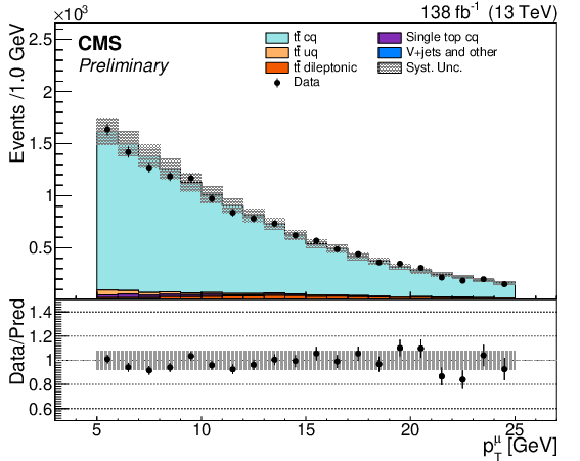
png pdf |
Figure 1-a:
Kinematic distributions of the muon inside the c-tagged jets after OS-SS subtraction (see text): transverse momentum pμT (top-left), pseudorapidity ημ (top-right), isolation (bottom-left), and pμT/pjetT (bottom-right). Events with a prompt electron or muon are considered. The grey band in the predictions represents the systematic uncertainties. The ratios of data to the expected yields are given at the bottom of each panel, together with the statistical and systematic uncertainties. |
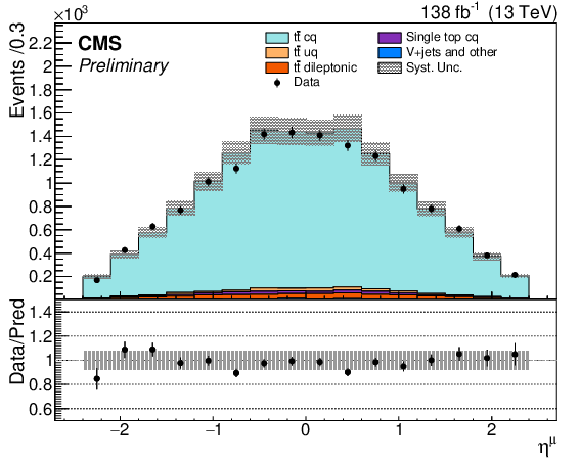
png pdf |
Figure 1-b:
Kinematic distributions of the muon inside the c-tagged jets after OS-SS subtraction (see text): transverse momentum pμT (top-left), pseudorapidity ημ (top-right), isolation (bottom-left), and pμT/pjetT (bottom-right). Events with a prompt electron or muon are considered. The grey band in the predictions represents the systematic uncertainties. The ratios of data to the expected yields are given at the bottom of each panel, together with the statistical and systematic uncertainties. |
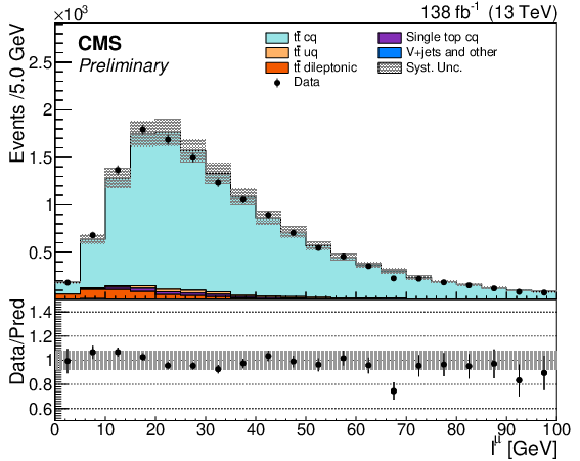
png pdf |
Figure 1-c:
Kinematic distributions of the muon inside the c-tagged jets after OS-SS subtraction (see text): transverse momentum pμT (top-left), pseudorapidity ημ (top-right), isolation (bottom-left), and pμT/pjetT (bottom-right). Events with a prompt electron or muon are considered. The grey band in the predictions represents the systematic uncertainties. The ratios of data to the expected yields are given at the bottom of each panel, together with the statistical and systematic uncertainties. |
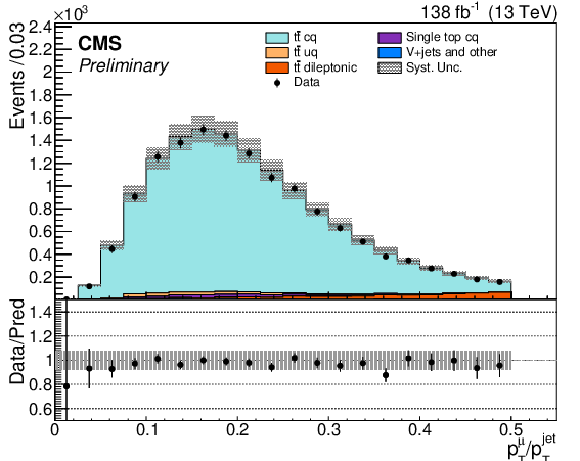
png pdf |
Figure 1-d:
Kinematic distributions of the muon inside the c-tagged jets after OS-SS subtraction (see text): transverse momentum pμT (top-left), pseudorapidity ημ (top-right), isolation (bottom-left), and pμT/pjetT (bottom-right). Events with a prompt electron or muon are considered. The grey band in the predictions represents the systematic uncertainties. The ratios of data to the expected yields are given at the bottom of each panel, together with the statistical and systematic uncertainties. |
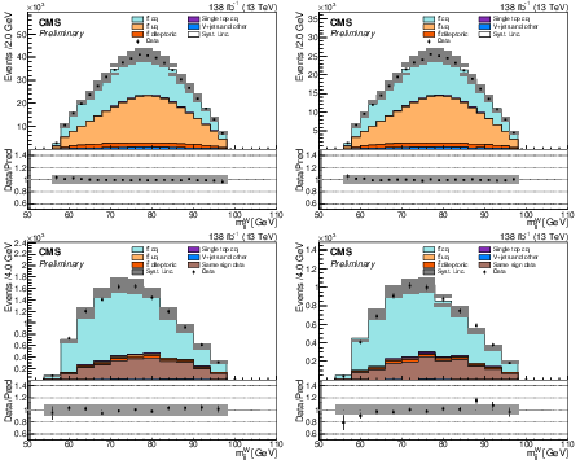
png pdf |
Figure 2:
Invariant mass of the two jets reconstructing the W boson, for the four event categories entering the fit: prompt muon and no charm tag (top-left), prompt electron and no charm tag (top-right), prompt muon and charm tag (bottom-left), prompt electron and charm tag (bottom-right). The measured data correspond to OS events, while the predictions from the simulations are OS-SS subtracted yields. The background prediction using the SS data is also shown. The grey band in the predictions represents the pre-fit systematic uncertainties. The ratios of data to the expected yields are given at the bottom of each panel together with the statistical and systematic uncertainties. |
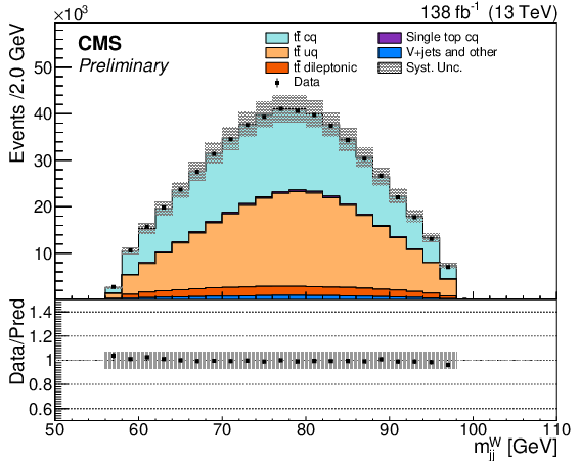
png pdf |
Figure 2-a:
Invariant mass of the two jets reconstructing the W boson, for the four event categories entering the fit: prompt muon and no charm tag (top-left), prompt electron and no charm tag (top-right), prompt muon and charm tag (bottom-left), prompt electron and charm tag (bottom-right). The measured data correspond to OS events, while the predictions from the simulations are OS-SS subtracted yields. The background prediction using the SS data is also shown. The grey band in the predictions represents the pre-fit systematic uncertainties. The ratios of data to the expected yields are given at the bottom of each panel together with the statistical and systematic uncertainties. |
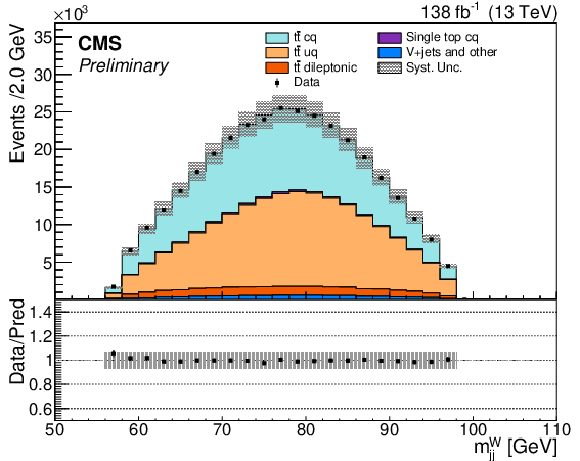
png pdf |
Figure 2-b:
Invariant mass of the two jets reconstructing the W boson, for the four event categories entering the fit: prompt muon and no charm tag (top-left), prompt electron and no charm tag (top-right), prompt muon and charm tag (bottom-left), prompt electron and charm tag (bottom-right). The measured data correspond to OS events, while the predictions from the simulations are OS-SS subtracted yields. The background prediction using the SS data is also shown. The grey band in the predictions represents the pre-fit systematic uncertainties. The ratios of data to the expected yields are given at the bottom of each panel together with the statistical and systematic uncertainties. |
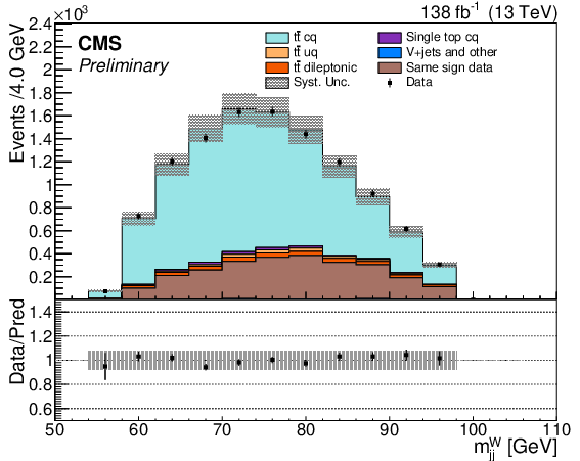
png pdf |
Figure 2-c:
Invariant mass of the two jets reconstructing the W boson, for the four event categories entering the fit: prompt muon and no charm tag (top-left), prompt electron and no charm tag (top-right), prompt muon and charm tag (bottom-left), prompt electron and charm tag (bottom-right). The measured data correspond to OS events, while the predictions from the simulations are OS-SS subtracted yields. The background prediction using the SS data is also shown. The grey band in the predictions represents the pre-fit systematic uncertainties. The ratios of data to the expected yields are given at the bottom of each panel together with the statistical and systematic uncertainties. |
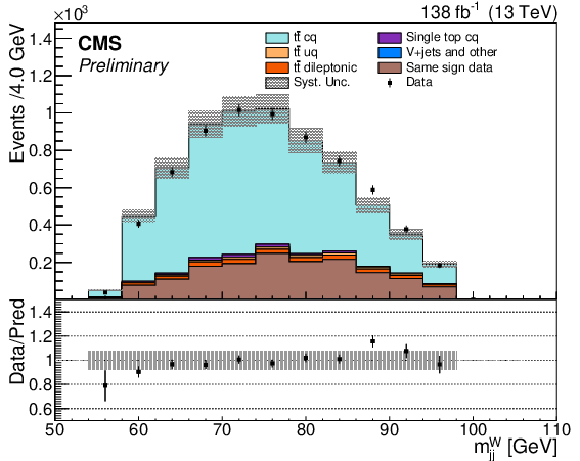
png pdf |
Figure 2-d:
Invariant mass of the two jets reconstructing the W boson, for the four event categories entering the fit: prompt muon and no charm tag (top-left), prompt electron and no charm tag (top-right), prompt muon and charm tag (bottom-left), prompt electron and charm tag (bottom-right). The measured data correspond to OS events, while the predictions from the simulations are OS-SS subtracted yields. The background prediction using the SS data is also shown. The grey band in the predictions represents the pre-fit systematic uncertainties. The ratios of data to the expected yields are given at the bottom of each panel together with the statistical and systematic uncertainties. |
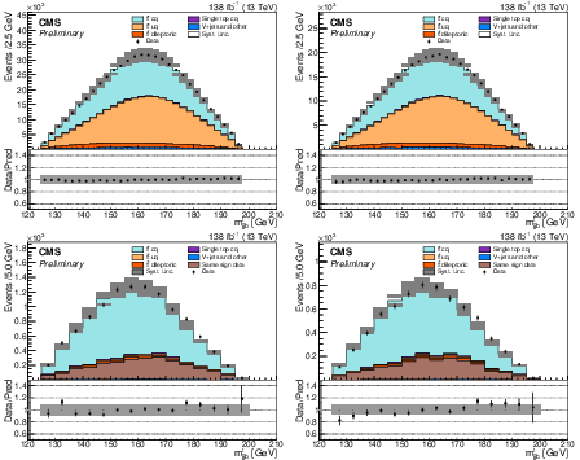
png pdf |
Figure 3:
Invariant mass of the three jets reconstructing the top quark, for the four event categories entering the fit: prompt muon and no charm tag (top-left), prompt electron and no charm tag (top-right), prompt muon and charm tag (bottom-left), prompt electron and charm tag (bottom-right). The measured data correspond to OS events, while the predictions from the simulations are OS-SS subtracted yields. The background prediction using the SS data is also shown. The grey band in the predictions represents the pre-fit systematic uncertainties. The ratios of data to the expected yields are given at the bottom of each panel together with the statistical and systematic uncertainties. |
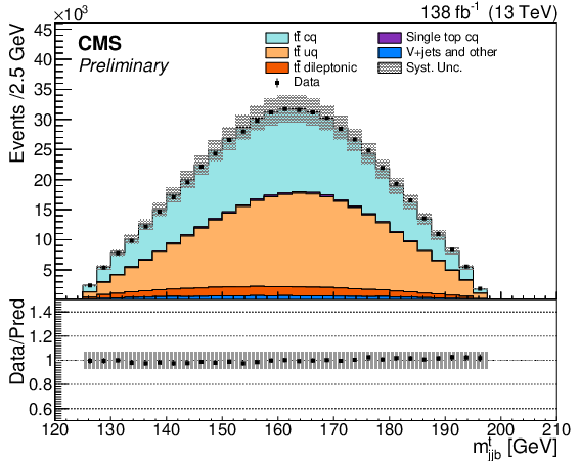
png pdf |
Figure 3-a:
Invariant mass of the three jets reconstructing the top quark, for the four event categories entering the fit: prompt muon and no charm tag (top-left), prompt electron and no charm tag (top-right), prompt muon and charm tag (bottom-left), prompt electron and charm tag (bottom-right). The measured data correspond to OS events, while the predictions from the simulations are OS-SS subtracted yields. The background prediction using the SS data is also shown. The grey band in the predictions represents the pre-fit systematic uncertainties. The ratios of data to the expected yields are given at the bottom of each panel together with the statistical and systematic uncertainties. |
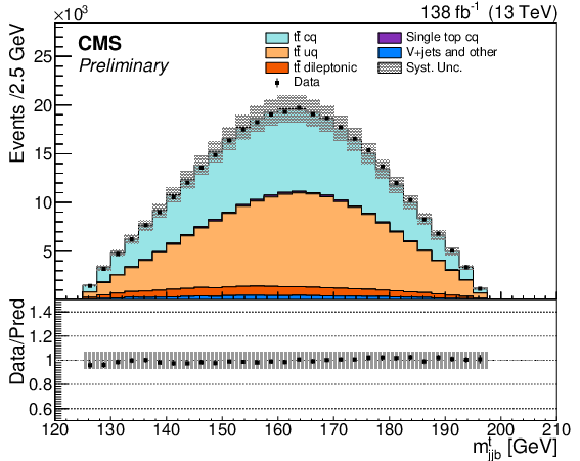
png pdf |
Figure 3-b:
Invariant mass of the three jets reconstructing the top quark, for the four event categories entering the fit: prompt muon and no charm tag (top-left), prompt electron and no charm tag (top-right), prompt muon and charm tag (bottom-left), prompt electron and charm tag (bottom-right). The measured data correspond to OS events, while the predictions from the simulations are OS-SS subtracted yields. The background prediction using the SS data is also shown. The grey band in the predictions represents the pre-fit systematic uncertainties. The ratios of data to the expected yields are given at the bottom of each panel together with the statistical and systematic uncertainties. |
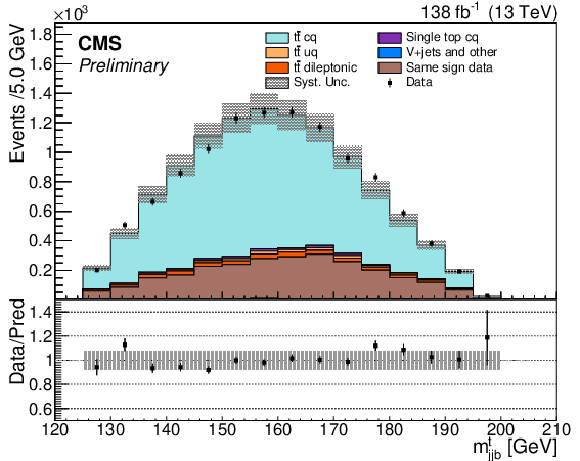
png pdf |
Figure 3-c:
Invariant mass of the three jets reconstructing the top quark, for the four event categories entering the fit: prompt muon and no charm tag (top-left), prompt electron and no charm tag (top-right), prompt muon and charm tag (bottom-left), prompt electron and charm tag (bottom-right). The measured data correspond to OS events, while the predictions from the simulations are OS-SS subtracted yields. The background prediction using the SS data is also shown. The grey band in the predictions represents the pre-fit systematic uncertainties. The ratios of data to the expected yields are given at the bottom of each panel together with the statistical and systematic uncertainties. |
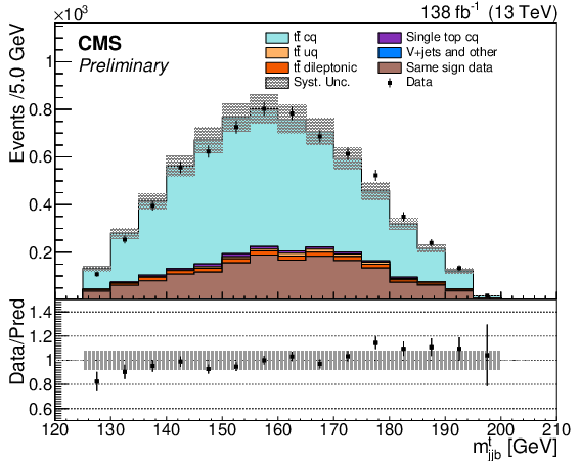
png pdf |
Figure 3-d:
Invariant mass of the three jets reconstructing the top quark, for the four event categories entering the fit: prompt muon and no charm tag (top-left), prompt electron and no charm tag (top-right), prompt muon and charm tag (bottom-left), prompt electron and charm tag (bottom-right). The measured data correspond to OS events, while the predictions from the simulations are OS-SS subtracted yields. The background prediction using the SS data is also shown. The grey band in the predictions represents the pre-fit systematic uncertainties. The ratios of data to the expected yields are given at the bottom of each panel together with the statistical and systematic uncertainties. |
| Tables | |
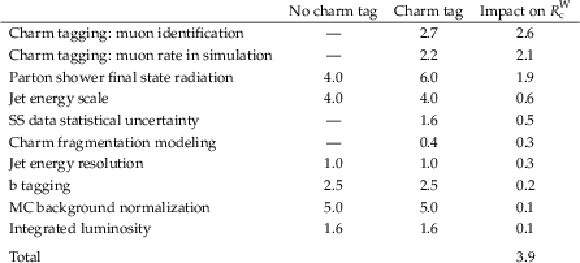
png pdf |
Table 1:
Summary of the main systematic uncertainties affecting the RWc measurement. The quoted numbers are the percentage change in the predicted yields of the samples with no charm and charm tag, and the last column reflects the impacts in percentage of the measured RWc value from each uncertainty source. |
| Summary |
| The most precise measurement to date of the W boson hadronic decay branching fraction ratio RWc = B(W→cq)/B(W→q¯q′) has been performed. The measurement is based on a data sample collected by the CMS experiment at a center-of-mass energy of 13 TeV in 2016--2018 at the CERN LHC and corresponding to an integrated luminosity of 138 fb−1. The large cross section of top quark-antiquark production at the LHC offers a sizable high-purity sample of W bosons suitable for this measurement. Events with one prompt charged lepton (electron or muon) and at least four jets, two of them tagged as b-jets, are analyzed. Charm jets are tagged using the presence of a muon inside the jet. This charm tagging method enables the selection of a pure sample of charm jets with a low level of background that is precisely determined from data. The measured RWc value is 0.489 ± 0.020, in good agreement with the standard model prediction. The precision of the measurement of 4%, limited by the systematic uncertainty in the charm tagging efficiency, is improved by a factor of two compared to the current world average value. From the RWc measurement, the sum of squared elements in the second row of the CKM matrix, 0.970 ± 0.041, and the Cabibbo--Kobayashi--Maskawa (CKM) matrix element |Vcs|= 0.959 ± 0.021 are derived. These results provide a consistency test of CKM unitarity and a measurement of |Vcs| from hadronic W boson decays. |
| References | ||||
| 1 | DELPHI Collaboration | Measurement of |Vcs| using W decays at LEP2 | PLB 439 (1998) 209 | |
| 2 | ALEPH Collaboration | A direct measurement of |Vcs| in hadronic W decays using a charm tag | PLB 465 (1999) 349 | |
| 3 | OPAL Collaboration | A measurement of the rate of charm production in W decays | PLB 490 (2000) 71 | hep-ex/0009020 |
| 4 | Particle Data Group Collaboration | Review of particle physics | Prog. Theor. Exp. Phys. 2022 (2022) 083C01 | |
| 5 | CMS Collaboration | Measurement of associated Z + charm production in proton-proton collisions at √s= 8 TeV | EPJC 78 (2018) 287 | CMS-SMP-15-009 1711.02143 |
| 6 | CMS Collaboration | Measurement of associated W + charm production in pp collisions at √s= 7 TeV | JHEP 02 (2014) 013 | CMS-SMP-12-002 1310.1138 |
| 7 | CMS Collaboration | Measurements of the production of a W boson in association with a charm quark in proton-proton collisions at √s= 8 TeV | EPJC 82 (2022) 1094 | CMS-SMP-18-013 2112.00895 |
| 8 | CMS Collaboration | Measurements of the production cross section for a W boson in association with a charm quark in proton-proton collisions at √s= 13 TeV | EPJC 84 (2024) 27 | |
| 9 | CMS Collaboration | The CMS experiment at the CERN LHC | JINST 3 (2008) S08004 | |
| 10 | CMS Collaboration | Performance of the CMS Level-1 trigger in proton-proton collisions at √s= 13 TeV | JINST 15 (2020) P10017 | CMS-TRG-17-001 2006.10165 |
| 11 | CMS Collaboration | The CMS trigger system | JINST 12 (2017) P01020 | CMS-TRG-12-001 1609.02366 |
| 12 | CMS Collaboration | Particle-flow reconstruction and global event description with the CMS detector | JINST 12 (2017) P10003 | CMS-PRF-14-001 1706.04965 |
| 13 | CMS Collaboration | Performance of the CMS muon detector and muon reconstruction with proton-proton collisions at √s= 13 TeV | JINST 13 (2018) P06015 | CMS-MUO-16-001 1804.04528 |
| 14 | CMS Collaboration | Technical proposal for the phase-II upgrade of the Compact Muon Solenoid | CMS Technical Proposal, CERN-LHCC-2015-010, CMS-TDR-15-02, 2020 CDS |
|
| 15 | M. Cacciari, G. P. Salam, and G. Soyez | The anti-kT jet clustering algorithm | JHEP 04 (2008) 063 | 0802.1189 |
| 16 | M. Cacciari, G. P. Salam, and G. Soyez | FastJet user manual | EPJC 72 (2012) 1896 | 1111.6097 |
| 17 | CMS Collaboration | Jet energy scale and resolution in the CMS experiment in pp collisions at 8 TeV | JINST 12 (2017) P02014 | CMS-JME-13-004 1607.03663 |
| 18 | CMS Collaboration | Performance of missing transverse momentum reconstruction in proton-proton collisions at √s= 13 TeV using the CMS detector | JINST 14 (2019) P07004 | CMS-JME-17-001 1903.06078 |
| 19 | CMS Collaboration | Measurement of the inclusive W and Z production cross sections in pp collisions at √s= 7 TeV | JHEP 10 (2011) 132 | CMS-EWK-10-005 1107.4789 |
| 20 | P. Nason | A new method for combining NLO QCD with shower Monte Carlo algorithms | JHEP 11 (2004) 40 | hep-ph/0409146 |
| 21 | S. Frixione, P. Nason, and C. Oleari | Matching NLO QCD computations with parton shower simulations: the POWHEG method | JHEP 11 (2007) 70 | 0709.2092 |
| 22 | S. Alioli, P. Nason, C. Oleari, and E. Re | A general framework for implementing NLO calculations in shower Monte Carlo programs: the POWHEG BOX | JHEP 06 (2010) 043 | 1002.2581 |
| 23 | J. Alwall et al. | The automated computation of tree-level and next-to-leading order differential cross sections, and their matching to parton shower simulations | JHEP 07 (2014) 079 | 1405.0301 |
| 24 | T. Sjöstrand et al. | An Introduction to PYTHIA 8.2 | Comput. Phys. Commun. 191 (2015) 159 | 1410.3012 |
| 25 | NNPDF Collaboration | Parton distributions from high-precision collider data | EPJC 77 (2017) 663 | 1706.00428 |
| 26 | CMS Collaboration | Extraction and validation of a new set of CMS Pythia8 tunes from underlying-event measurements | EPJC 80 (2020) 4 | CMS-GEN-17-001 1903.12179 |
| 27 | GEANT4 Collaboration | GEANT 4--a simulation toolkit | NIM A 506 (2003) 250 | |
| 28 | CMS Collaboration | Electron and photon reconstruction and identification with the CMS experiment at the CERN LHC | JINST 16 (2021) P05014 | CMS-EGM-17-001 2012.06888 |
| 29 | CMS Collaboration | Identification of heavy-flavour jets with the CMS detector in pp collisions at 13 TeV | JINST 13 (2018) P05011 | CMS-BTV-16-002 1712.07158 |
| 30 | E. Bols et al. | Jet flavour classification using DeepJet | JINST 15 (2020) P12012 | 2008.10519 |
| 31 | M. Lisovyi, A. Verbytskyi, and O. Zenaiev | Combined analysis of charm-quark fragmentation-fraction measurements | EPJC 76 (2016) 397 | 1509.01061 |
| 32 | M. Czakon and A. Mitov | Top++: A program for the calculation of the top-pair cross-section at hadron colliders | Comput. Phys. Commun. 185 (2014) 2930 | 1112.5675 |
| 33 | J. Campbell, T. Neumann, and Z. Sullivan | Single-top-quark production in the t-channel at NNLO | JHEP 02 (2021) 040 | 2012.01574 |
| 34 | N. Kidonakis and N. Yamanaka | Higher-order corrections for tW production at high-energy hadron colliders | JHEP 05 (2021) 278 | 2102.11300 |
| 35 | CMS Collaboration | Measurement of W and Z boson inclusive cross sections in pp collisions at 5.02 and 13 TeV | CMS Physics Analysis Summary, 2023 CMS-PAS-SMP-20-004 |
CMS-PAS-SMP-20-004 |
| 36 | CMS Collaboration | W+W− boson pair production in proton-proton collisions at √s= 13 TeV | PRD 102 (2020) 092001 | CMS-SMP-18-004 2009.00119 |
| 37 | A. M. Sirunyan et al. | Measurements of pp→ZZ production cross sections and constraints on anomalous triple gauge couplings at √s=13TeV | EPJC 81 (2021) 200 | 2009.01186 |
| 38 | CMS Collaboration | Measurement of the inclusive and differential WZ production cross sections, polarization angles, and triple gauge couplings in pp collisions at √s= 13 TeV | JHEP 2022 (2022) 32 | CMS-SMP-20-014 2110.11231 |
| 39 | CMS Collaboration | Precision luminosity measurement in proton-proton collisions at √s= 13 TeV in 2015 and 2016 at CMS | EPJC 81 (2021) 800 | CMS-LUM-17-003 2104.01927 |
| 40 | CMS Collaboration | CMS luminosity measurement for the 2017 data-taking period at √s= 13 TeV | CMS Physics Analysis Summary, 2018 CMS-PAS-LUM-17-004 |
CMS-PAS-LUM-17-004 |
| 41 | CMS Collaboration | CMS luminosity measurement for the 2018 data-taking period at √s= 13 TeV | CMS Physics Analysis Summary, 2019 CMS-PAS-LUM-18-002 |
CMS-PAS-LUM-18-002 |
| 42 | CMS Collaboration | Measurement of the inelastic proton-proton cross section at √s= 13 TeV | JHEP 07 (2018) 161 | CMS-FSQ-15-005 1802.02613 |
| 43 | CMS Collaboration | Measurement of differential t¯t production cross sections in the full kinematic range using lepton+jets events from proton-proton collisions at √s= 13 TeV | PRD 104 (2021) 092013 | CMS-TOP-20-001 2108.02803 |
| 44 | DELPHI Collaboration | A Measurement of D meson production in Z0 hadronic decays | Z. Phys. C 59 (1993) 533 | |
| 45 | OPAL Collaboration | A Measurement of the production of D∗± mesons on the Z0 resonance | Z. Phys. C 67 (1995) 27 | |
| 46 | ALEPH Collaboration | Study of charm production in Z decays | EPJC 16 (2000) 597 | hep-ex/9909032 |
| 47 | CMS Collaboration | The CMS statistical analysis and combination tool: \textscCombine | Submitted to Comput. Softw. Big Sci, 2024 | CMS-CAT-23-001 2404.06614 |
| 48 | CMS Collaboration | Precision measurement of the W boson decay branching fractions in proton-proton collisions at √s= 13 TeV | PRD 105 (2022) 072008 | CMS-SMP-18-011 2201.07861 |

|
Compact Muon Solenoid LHC, CERN |

|

|

|

|

|

|